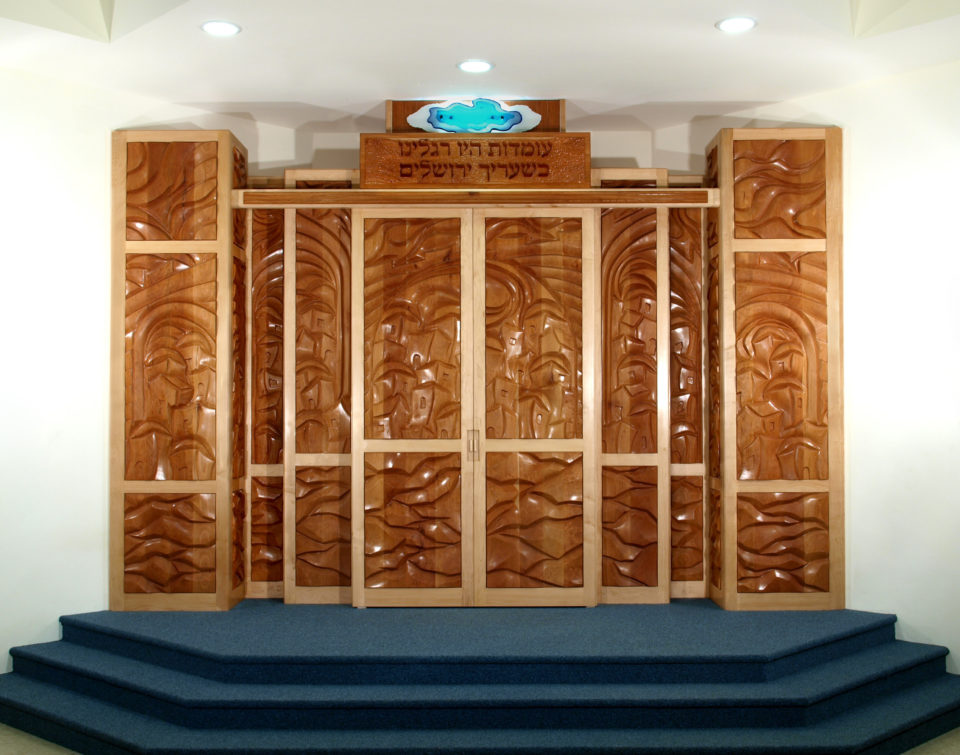 I have been designing and creating one of a kind pieces of functional art in solid hardwoods for over two decades. I would like to think that I’ve progressed over this period, both as an artist and as a craftsman. I’ve made many improvements and changes in my technique as well as in my perspective. However, one thing hasn’t changed. I still view the creation of the torah ark, or aron kodesh, as one of the pinnacles of my work.
I have been designing and creating one of a kind pieces of functional art in solid hardwoods for over two decades. I would like to think that I’ve progressed over this period, both as an artist and as a craftsman. I’ve made many improvements and changes in my technique as well as in my perspective. However, one thing hasn’t changed. I still view the creation of the torah ark, or aron kodesh, as one of the pinnacles of my work.
The aron kodesh is unequivocally the most important and the most visible piece of synagogue furniture. It is placed along the wall facing Jerusalem, towards which the entire congregation faces while praying, most particularly during several dramatic and significant moments during the service. Aronot kodesh have, therefore, more prime-time viewing than any other piece of synagogue furniture. It is only fitting, then, that the aron kodesh should be endowed with beautiful and spiritually uplifting wood art. It is true that other kinds of synagogue furniture, such as the torah reading table, or bimah, and the podium, or amoud li’chazan, also offer an ample canvas for symbolic wood art. However, for the purposes of this article I will confine the subject to that most central focal point of synagogue furniture, namely the aron kodesh.
Here are a few of the most common themes which traditionally appear in the context of art work for the aron kodesh:
- The Ten Commandments
- The Tree of Life
- Mount Sinai
- The Twelve Tribes.
Here are a few slightly less common themes:
- The Holy Breast Plate of the High Priest
- Jerusalem
- The parting of the Red Sea
- The Eternal Flame
- The Cherubs of the Holy Temple
I view myself as a link in the ongoing chain of artists and artisans who have sought throughout the centuries to create glorious torah arks for our places of worship. I strive to achieve this by creating original wood art that stems from tradition yet speaks to today’s audience. In my eyes some of the more traditional artistic themes for synagogue furniture art have been over-used and become ubiquitous and uninspiring. Therefore, I am constantly looking for new imagery which will instill in the congregants an uplifting sense of awe and beauty. However, I would say that most often I tend to reinterpret some of the tried and true symbols, rendering them in my own unique style with my own a personal, artistic touch. The following are a few examples of such synagogue furniture which can be seen on my web site:
- The Silver Leafed Aron Kodesh (Ark) – An interpretation of the tree of life theme
- The Mount Sinai Aron Kodesh (Ark) – A semi-abstract interpretation of the Mount Sinai theme
- The Parting the Waves Bimah – A wild and free-flowing interpretation of the parting of the Red Sea
By incorporating these symbols into synagogue art the congregant is subtly reminded of some of the core values inherent in the Jewish tradition. He or she is thus encouraged to feel a personal connection with our people’s heritage. The wood art for the aron kodesh is often supplemented by use of a biblical verse which exemplifies the particular value the congregation wishes to stress and uphold. When I design an aron kodesh for a synagogue I meet with the rabbi and members of the building committee. I always try to glean an inner understanding of the congregation’s gestalt. This allows me to direct the symbolism I will use to express and augment the spirit each particular sanctuary.
In summary, we have seen the importance of the torah ark, or aron kodesh as a venue for transmitting traditional Jewish messages and values through use of symbols. We have also noted how today’s artists sometimes use modern forms to carry on the flame of tradition.

